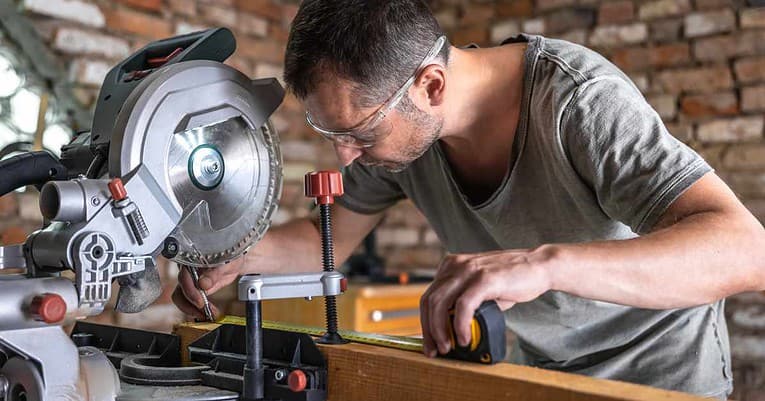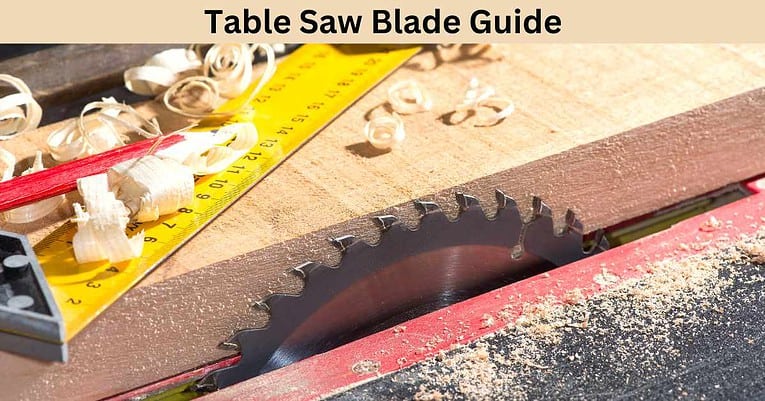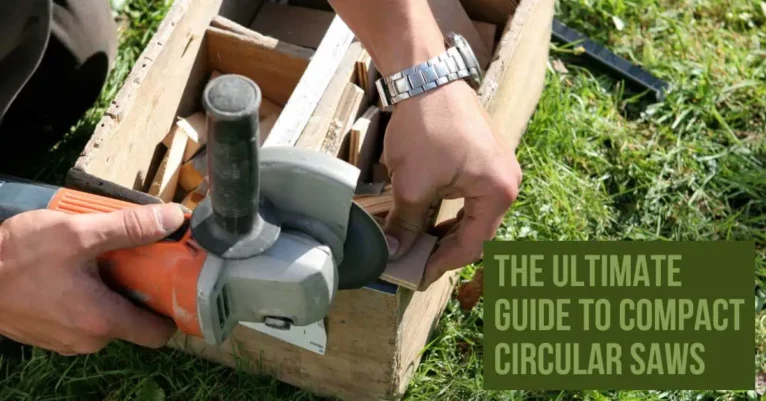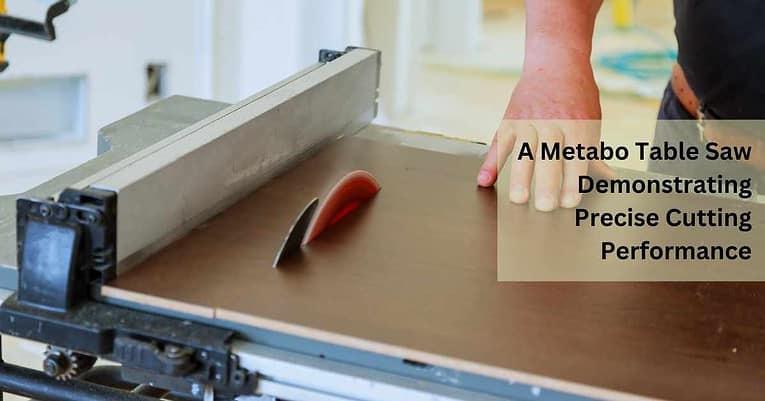Miter Saw vs Circular Saw: Choosing the Right Tool
Miter Saw vs Circular Saw: Introduction
In woodworking and construction, selecting the appropriate tool for a project can greatly impact work efficiency and quality. Two commonly compared tools are the miter saw and circular saw, both of which play an important role in a carpenter’s toolkit. While each has its unique traits and benefits to offer, understanding their differences is crucial to choose the optimal tool for any given task.
A miter saw is designed with precision in mind, ideal for angled cuts often employed in framing, molding, or fine detail work. Since it stays stationary during use overall accuracy levels remain high as opposed to some handheld options. It offers diverse features like miters bevels or compound cuts available across ranges specific models provide.
On the other hand, a circular saw is an adaptable option more suitable across a broader range of applications due to its portability. Limited by mainly being useful only to make straight cuts but with refinement could also do medium grade beveled edged items. Some tasks completed by this robust design include cutting through timber, and pieces into required shapes sheets from plywood alongside even demolition work if necessary.
Understanding these contrasts- how they relate to different situations and respective strengths and weaknesses will aid any artisan regardless of season veteran or amateur should allow them to maximize their performance upon tackling projects efficiently.
You may also like:
- Powerful and Portable: Explore the 10 Best Cordless Miter Saws for Professionals
- Power and Precision: Comparing Worm Drive Saw vs Circular Saw
- Perfecting the Basics: Find the Best Miter Saw for Novice Woodworkers
- Your DIY Guide: Using a Circular Saw Without a Table
- Top 5 Worm Drive Circular Saws: A Comprehensive Review
- Top Circular Saw Blades for Plywood: Choose the Right Blade for the Job
What is a Miter Saw?

A miter saw is a precision woodworking tool that produces accurate, quick crosscuts and angle cuts. This popular tool is favored by carpenters and woodworkers for making miters (angled cuts) across the grain of the board.
Design and Component Parts
The miter saw design features several key components, including a base, table, motorized blade, fence, and swing arm with adjustable angles. The workpiece is positioned on the stable base and held securely to the perpendicular fence for optimal cutting accuracy.
Typical Uses
Miter saws are commonly used for various projects such as picture frames, door frames, crown molding, and furniture making due to their precise cutting ability. Compound miter saws can tilt in one or both directions allowing bevel cuts while sliding miter saws move forwards and backward increasing their length capacity.
Limitations
However, they have limitations such as the inability to make long rip-cuts along the grain of the wood or struggles with thicker pieces because of their limited blade size. Moreover, Miter Saw being stationary requires movement of the workpiece towards it which makes them less portable compared to other equipment tools.
What is a Circular Saw?

A circular saw is an adaptable and durable tool frequently used in woodworking and construction settings. Known for its extensive power range combined with portability, it’s a top pick for straight cuts on various materials.
Design and parts
The chief characteristic of the circular saw is its blade, which operates from an electric motor. It’s hand-held and available as either corded or cordless types. A shoe or base plate rests upon the material that helps maintain control and stability while cutting. Customized adjustments can be done to regulate the depth/angle of the cut required.
Typical uses
The foremost use of these kinds of saws is primarily seen in woodcuts; however, tailor-made blades can work through metal, plastic, masonry, or more with ease too! They are very efficient at doing cross-cuts or long-rip cuts proficiently. Their portable design makes them most appropriate for site-based projects where workers need to move around constantly.
Strengths
Versatility is this tool’s USP since numerous different types of cuts could be made using any kind of material effortlessly by just changing blades. Being movable allows you greater flexibility while working on significant/thicker products compared to other alternatives like a Miter Saw offering better handling comfort during usage while getting your job done quickly!
Limitations
Although very powerful, the circular saw does have its limitations. It’s not as precise as a miter saw when it comes to making accurately angled cuts, requiring greater skill and practice for obtaining clean straight-edge wieldy makes. The risk element is significantly higher using this handheld product because of the exposed cutting edge compared to other more rigidly designed alternatives such as Miter Saw that keeps safety checks in mind while creating their products.
Miter Saw vs Circular Saw: Which is the Best for You?
When it comes to power tools, miter saws and circular saws are two of the most essential ones that every DIY enthusiast or professional woodworker should have. These saws are designed to make a wide range of cuts in several materials, from hardwood to softwood and plastic.
Despite their similarities, these two types of saws differ in various ways. In this article, we will help you understand how miter saw differs from the circular saw so that you can determine which one is best suited for your specific project requirements.
Comparison of Functionality
Type of Cuts Each Can Make
Miter Saws – As the name implies, a miter saw is ideal for making angled cuts with its ability to rotate at an angle of up to 45 degrees along one axis called ‘miter.’ It also has bevel capabilities where it pivots on another axis allowing you to tilt your blade perpendicular to a material’s face.
Circular Saws – A circular hand-held power tool features a fixed base plate ideal for cutting straight lines through large lumber as well as making long rip-cuts using guide rails or smaller pieces with precision.
Material Compatibility
Mitre Saws-Due to their precision and ability to make precise angled cuts, miter saws are best suited for working with materials that require clean edges such as moldings, trims, picture frames, and so on. They work well with delicate woods, and composites including PVC among others.
Circular Saws – Circular saws can handle just about any material thrown at them from softwoods to hardwoods, sheet metal (with proper blade), and plastics among other items.
Comparison of Versatility Range of Projects Suited for Each
Miter Saws – These slick machines serve one fundamental purpose- making high-volume straight or angled crosscuts in a vast array of milled lumber types suitable when working on tasks requiring clean and controlled cuts especially angle-driven like molding works and cutting bevel triangles.
Circular Saw – Because it’s a highly mobile power tool option users can easily walk around with this hassle-free machine reducing the need for individual woodworking stations perfecting projects that would have been much more difficult compared had they used a regular stationary woodworking tool.
Adaptability to Different Work Environments
Mitre Saws-The miter saw has a distinct set of requirements & needs assistance from permanent surfaces where they’re stationed because Miters saw(s) follow an easy traditional positioning rule: Take specific rough-in measurements so that you can get a pre-determined and repeatable cutting position for your material. This is why, miter saws are better suited to indoor environments like workshops.
Circular Saw – Circular saws are versatile in terms of environmental adaptability since they have no specific setup requirements. Along with being lightweight, compact & easily portable making them ideal for outdoor projects or job sites.
Comparison of Safety Features
Both miter saws and circular saws offer certain safety features such as snugs that ensure that the wood being cut remains stationary while work proceeds on it alongside the usual standard protective gear for personal safety concerns to avoid eye injury or debris inhalation into the lungs.
Mitre Saws: Most tools come equipped with blade guards which help protect operators from littered flying debris caused by the tool’s high-velocity rotating blades
Circular Saws: Machines typically require the use of two hands to operate efficiently thereby reducing instances where an accidental switch-on button press leads to catastrophic workplace injuries.
Miter Saw vs Circular Saw: Comparison of Costs
The cost factor varies across many different factors; scope, efficiency levels, and options/brands among others. The cheapest basic versions may start at around $100+ though depending on more complex designs/features prices could go up ranging between hundreds to thousands each.
Comparison of Ease of Use and Learning Curve
Mitre Saws: It takes a few tries to get the hang of it but miter saws are relatively easy for beginners. Most models have guides to help you attain accurate cuts that make even newbies approachable.
Circular Saw – Aside from having a slight learning curve, circular saws are also flexible machines; usually taking beginners some time to brush up on maneuvering around woods especially when cutting out intricate shapes or angles.
Use Cases: When to Use a Miter Saw vs. a Circular Saw
Scenarios Best Suited for a Miter Saw:
- Cutting Precise Angles: When you need to make accurate and precise angled cuts, a miter saw is the best tool for the job.
- Crown Molding Installation: The unique blade design of a miter saw makes it an ideal choice for cutting crown molding at different angles and with exceptional accuracy.
- Framing Work: A miter saw comes in handy when precision cutting of trim boards or lumber is required during framing work requiring straight or angled edges.
- Baseboard Installation – Another scenario that requires good precision when measuring length as well as angle is baseboard installation, which can be accomplished perfectly with a miter saw.
Scenarios Best Suited for a Circular Saw:
- Long Narrow Cuts – Unlike rigid blades found on miter-saws geared toward making perpendicular cuts into shorter stock lengths only, circular saws come equipped with flexible carbide tipped blades suitable for generating longer linear rip-cuts – typical of decking planks, large plywood sheets, etc.,
- Roof Shingle Replacement – For contractors who replace roof shingles regularly or DIY enthusiasts looking to replace their rooftop themselves, the circular saw will be the appropriate gear since above-cutting would require long vertical rips, making a circular saw ideal tool for this type of cutting.
- Cut Large Pieces of Wood: When you have to cut large pieces of wood that are too big for a miter saw, a circular saw may be your best bet as it can handle more substantial stocks while still delivering accurate cuts.
- General Construction Work: Circular saws are highly versatile and can get many jobs done on any construction site. However, if you need precise angled work or crown moldings and trimming work needs to be done perfectly; that’s when the Miter Saw comes in handy.
Expert Recommendations and Tips
 Advice for Beginners Choosing Between the Two:
Advice for Beginners Choosing Between the Two:
- Consider your Projects: Before deciding between a miter saw or circular saw, it’s important to consider the type of projects you will be working on regularly.
- Budget Constraints: Cost plays an important role as well. While miter saws are generally more expensive than circular ones, their added features and precision might justify paying extra for some people’s jobs.
- Flexibility Needs – Understanding project demands that might require running longer cuts should inform the choice between either gear in order not to encounter production delays or hiccups mid-task due to unsuitable tool choices made earlier.
Maintenance Tips for Both Saws:
- Keep Blades Sharp: Always keep your blades sharpened after a few uses since dull blades cause less precise cuts making work harder than need be.
- Regular Cleaning – Making sure to remove dirt buildup regularly from areas such as vents and moving parts keeps both types of tools functioning at optimum levels continually reducing frictional wear which could cause assembly damage over time.
- Lubricate Moving Parts – Applying lubricant oil helps prevent rusting while keeping every part moving smoother helping improve durability while extending overall lifespan too.
Tips for Safe Usage:
- Wear Eye Protection- It’s crucial to protect your eyes when using both types of saws by wearing safety glasses or goggles.
- Use Appropriate Safety Gear – Wear gloves, ear protection, and dust masks when necessary based on task demands
- Read the User Manual: Ensure you understand instructions before handling any equipment. Understanding basic stuff such as cord placement, control-switch placement settings, etc., gives added confidence, especially for individuals handling these gears for the first time
- Keep Your Workspace Clear- Ensure that there’s enough space around you while operating either a circular saw or miter saw. Clearing off debris from workspace topsides prevents slips /cuts; unexpected production damage due to accidental short-circuits is curtailed too
- Avoid Loose Clothing – it’s important to dress appropriately without wearing loose clothing like long sleeves or baggy pants so they won’t get caught up in any moving parts of machines.
Final Thoughts
Choosing the right saw for specific needs depends largely on your intended use case. If you need to make precise angled cuts or trim work like baseboards or crown molding installation- then a miter saw is your best bet as it offers excellent accuracy and precision in making such cuts. On the other hand, if you are looking for something that can handle different materials and deliver longer linear rip-cuts, a circular saw would probably be more suitable.
Before making any purchase decision between these gears though, consider practical factors like budget constraints, workspace size available storage space among others while taking into consideration the durability /versatility benefits of gear longevity after high-volume jobs.
Regardless of what type of saw you decide to acquire at last always prioritize maintenance tasks/goals even as safety-consciousness mindful habits during production times should remain sacrosanct best practices towards achieving professional-grade outcomes regardless of skill levels.

 Advice for Beginners Choosing Between the Two:
Advice for Beginners Choosing Between the Two:


![Best Cabinet Table Saw cuttinpro.com Best Cabinet Table Saw – Top 8 Picks [Reviewed]](https://cuttinpro.com/wp-content/uploads/2023/02/Best-Cabinet-Table-Saw--766x401.jpg)


